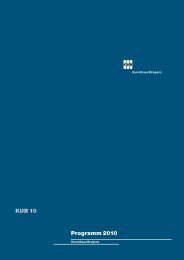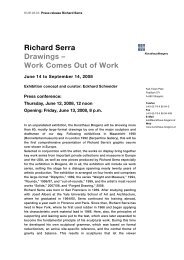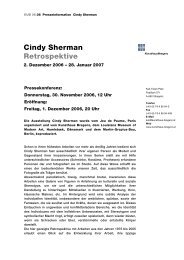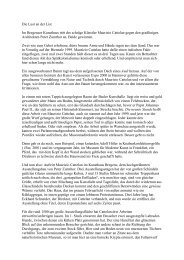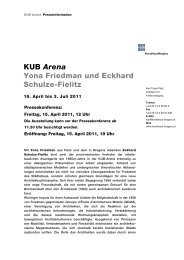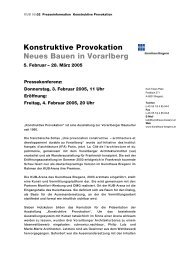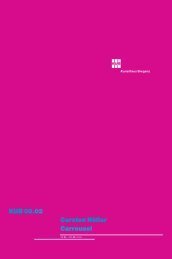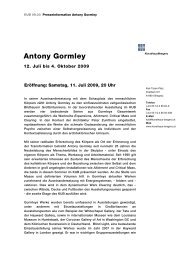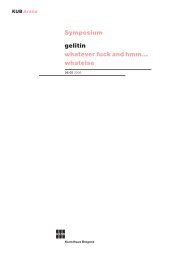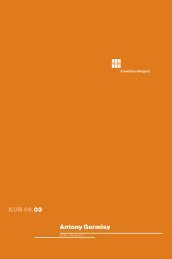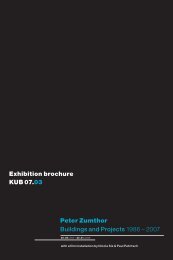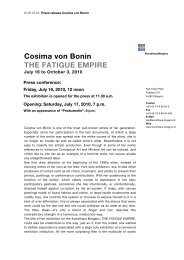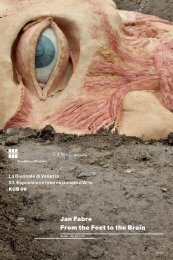Janet Cardiff & George Bures Miller The Secret Hotel
Janet Cardiff & George Bures Miller The Secret Hotel
Janet Cardiff & George Bures Miller The Secret Hotel
Create successful ePaper yourself
Turn your PDF publications into a flip-book with our unique Google optimized e-Paper software.
KUB 05.08 Press release <strong>Janet</strong> <strong>Cardiff</strong> & <strong>George</strong> <strong>Bures</strong> <strong>Miller</strong><br />
<strong>Janet</strong> <strong>Cardiff</strong> &<br />
<strong>George</strong> <strong>Bures</strong> <strong>Miller</strong><br />
<strong>The</strong> <strong>Secret</strong> <strong>Hotel</strong><br />
November 26, 2005 thru January 15, 2006<br />
Press conference:<br />
Thursday, November 24, 2005, 12.00 noon<br />
Opening:<br />
Friday, November 25, 2005, 8.00 p.m.<br />
Over the past two decades, <strong>Janet</strong> <strong>Cardiff</strong> & <strong>George</strong> <strong>Bures</strong> <strong>Miller</strong> (*1957 in<br />
Brussels, Canada; *1960 in Vegreville, Canada) have developed an<br />
impressive series of collaborative pieces, complementing each other’s work<br />
in an ingenious way. In their art, they combine image, video, and sound, as<br />
well as architectural and sculptural installations that take the viewer on a<br />
confusing and fascinating journey. Sound and a special binaural recording<br />
and playback technology are key components in their installations, producing<br />
a highly sensitive and spatial audio and sensory experience. <strong>The</strong>ir work<br />
evokes thoughts and associations that become inextricably interwoven with<br />
personal experiences, thus creating a constantly changing new fiction.<br />
<strong>Janet</strong> <strong>Cardiff</strong> & <strong>George</strong> <strong>Bures</strong> <strong>Miller</strong>’s work has been shown at such major<br />
international exhibition venues as the PS1, New York, the Musée d’Art<br />
Contemporain, Montreal, the Astrop Fearnley Museum, Oslo, the Castello<br />
Rivoli in Turin, the Portikus, Frankfurt, and the Whitechapel Art Gallery in<br />
London. One of their most well-known works is “<strong>The</strong> Paradise Institute,”<br />
which was their award-winning contribution to the Venice Biennial 2001 and<br />
is also being shown in Bregenz. For the Kunsthaus Bregenz, <strong>Cardiff</strong> & <strong>Miller</strong><br />
have created three new works („Pianorama“, „<strong>The</strong> <strong>Secret</strong> <strong>Hotel</strong>“ and „Opera<br />
for a small Room“) which can be seen in part as a direct reference to or an<br />
intervention in the architecture designed by Peter Zumthor. In cooperation<br />
with the Johanniterkirche in Feldkirch, <strong>Janet</strong> <strong>Cardiff</strong>, like Anish Kapoor and<br />
Jenny Holzer before them, was also willing to select a work to be installed<br />
inside the church. “<strong>The</strong> Forty-Part Motet” (2001), a re-working of the choral<br />
piece “Spem in Alium” by Thomas Tallis, played back through 40 speakers<br />
which have been arranged in this historical nave, will give visitors a truly<br />
impressive spatial and audio experience.<br />
Karl-Tizian-Platz<br />
Postfach 371<br />
A-6901 Bregenz<br />
Telefon<br />
(+43-55 74) 4 85 94-0<br />
Fax<br />
(+43-55 74) 4 85 94-8<br />
E-Mail<br />
kub@kunsthaus-bregenz.at<br />
Web<br />
www.kunsthaus-bregenz.at
2/10<br />
KUB 05.08 Press release <strong>Janet</strong> <strong>Cardiff</strong> & <strong>George</strong> <strong>Bures</strong> <strong>Miller</strong><br />
Ground Floor<br />
Pianorama, 2005<br />
An old fashioned upright piano sits in the middle of the space. <strong>The</strong>re are two<br />
small loudspeakers facing the keyboard. A mechanical device called a<br />
Playola which plays the piano sits on top of the keys. Out of one loudspeaker<br />
comes <strong>Janet</strong>’s voice and out of the other comes <strong>George</strong>’s. <strong>The</strong>se voices are<br />
discussing what type of music might be appropriate for what seems to be a<br />
film they are planning, but it is never clear what type of film it is or what it is<br />
about. <strong>Janet</strong>’s voice describes a scene such as: “She’s walking down an<br />
alley. <strong>The</strong> camera follows her with a wide shot then goes to a close shot from<br />
behind.” <strong>The</strong> keys being moved by the mechanical solenoids attached above<br />
them respond to her voice and play a few chords of ghostly music. <strong>The</strong> fourhanded<br />
piano composition continues as <strong>Cardiff</strong> and <strong>Miller</strong> go on to describe<br />
other scenes from the hypothetical film and the piano responds. <strong>The</strong> whole<br />
effect is eerie.<br />
First Floor<br />
<strong>The</strong> Paradise Institute, 2001<br />
Loan: Castello di Rivoli – Museo d’Arte Contemporanea, Turin<br />
Viewers approach a simple plywood pavilion, they mount a set of stairs and<br />
enter a lush, dimly-lit interior complete with red carpet and two rows of velvet<br />
seats. Once seated, they peer over the balcony onto a miniature replica of a<br />
grand old movie theater. Viewers then put on the headphones provided, and<br />
the 13-minute projection begins.<br />
<strong>The</strong> soundtrack of the film creates one level of illusion, while another is<br />
produced by the supposed audience. <strong>The</strong> film is a mix of genres: it is part<br />
thriller, part film noir, part sci-fi, and part experimental film. What is more<br />
particular about the installation is the personal binaural “surround sound.”<br />
<strong>The</strong> sense of isolation one might experience is interrupted by intrusions<br />
seemingly coming from inside the theater. A cell phone belonging to a<br />
member of the audience rings. A close female friend whispers intimately in<br />
your ear, “Did you check the stove before we left?” Fiction and reality<br />
become intermingled as absorption in the film is suspended, and other<br />
realities flow in.
3/10<br />
KUB 05.08 Press release <strong>Janet</strong> <strong>Cardiff</strong> & <strong>George</strong> <strong>Bures</strong> <strong>Miller</strong><br />
Second Floor<br />
<strong>The</strong> <strong>Secret</strong> <strong>Hotel</strong>, 2005<br />
You enter a room with a low ceiling and notice a set of stairs leading up. This<br />
stairwell is made of wood, lined with wallpaper reminiscent of an old<br />
American hotel. When you reach the top you arrive at a walkway above the<br />
frosted glass ceiling panels. Strange noises like that of an old industrial<br />
building mingle around you. As you continue along the walkway above the<br />
ceiling you see an opening in the glass. Looking into this opening your vision<br />
is thrust down a long shaft to a very small room at the bottom which seems<br />
to be far below. Your spatial understanding is confused since you know that<br />
you have just been on the floor below and that it is not possible to have a<br />
room there. A bed, a chair and a record player are the only things in this<br />
small room. From the record player comes the sound of a forgotten record<br />
which has got stuck.<br />
Third Floor<br />
Opera for a Small Room, 2005<br />
<strong>Cardiff</strong> & <strong>Miller</strong> describe this work as follows: “R. Dennehy lived most of his<br />
life in Salmon Arm, Canada. A lot is not known about him. One thing we know<br />
is that at one time he collected opera records. He was especially infatuated<br />
with the great tenors. We know these facts because we bought all of his<br />
records (which were signed at the top) at the second hand store in Salmon<br />
Arm, British Columbia.<br />
“We are interested in the extreme cultural juxtaposition of opera and the<br />
small western town in which R. Dennehy lived/lives. What did he think about<br />
while listening to these records recorded in foreign cities half way around the<br />
world. Was he a trained singer? Did he want to have a career in opera? Did<br />
he lose a lover and find solace in the music? Did he always imagine traveling<br />
one day to these faraway opera houses? We imagine that he sings along to<br />
the records creating his own opera of displaced time and space.<br />
“So we made a small room for the opera of his life. <strong>The</strong>re are 24 antique loud<br />
speakers out of which come various songs, sounds and arias, and occasional<br />
pop tunes. <strong>The</strong>re are almost two thousand records stacked around the room<br />
and 8 record players which seem to play all at once, sometimes sampling
4/10<br />
KUB 05.08 Press release <strong>Janet</strong> <strong>Cardiff</strong> & <strong>George</strong> <strong>Bures</strong> <strong>Miller</strong><br />
lines, speeding up and slowing down just as a contemporary DJ would do. A<br />
man’s shadow, moving to the rhythm of the music is back-projected onto a<br />
screen in the center of the array of turntables as if he is the DJ. His voice is<br />
the only thing projected outside of the space of the room on an outdoor<br />
broadcast speaker. He has a microphone in front of him. He is playing a<br />
series of records, talking and singing to himself. Maybe he sings to his<br />
collection of voices or perhaps to a particular woman, you can’t be sure. <strong>The</strong><br />
music mixes from poignant arias to a cacophony of voices and rhythms.<br />
Perhaps he is inventing a relationship with all of these voices and characters<br />
creating an aria for his own life.<br />
“<strong>The</strong> audience cannot enter into the room but only look through dusty<br />
windows, holes in the walls, and cracks in doorways to see and hear his<br />
world. Through the use of lighting the piece shifts in feeling from a nostalgic<br />
setting of an old attic room to that of a night club or theater stage. Colored<br />
lights sequence around the room, coming on and off, fading up and down or<br />
pulse to emphasize the mood and beat of the music.”
5/10<br />
KUB 05.08 Press release <strong>Janet</strong> <strong>Cardiff</strong> & <strong>George</strong> <strong>Bures</strong> <strong>Miller</strong><br />
Johanniterkirche Feldkirch<br />
<strong>Janet</strong> <strong>Cardiff</strong><br />
<strong>The</strong> Forty-Part Motet, 2001<br />
November 25, 2005 – January 15, 2006<br />
Opening: November 25, 2005, 5 p.m.<br />
“<strong>The</strong> Forty-Part Motet” will be presented in a historical church setting in<br />
conjunction with the ongoing cooperation between the Kunsthaus Bregenz<br />
and the Johanniterkirche Feldkirch. <strong>The</strong> installation plays back a re-working<br />
of Thomas Tallis’ 16 th century polyphonic composition “Spem in Alium,” in<br />
which each voice of the 40-person Salisbury Cathedral Choir was recorded<br />
separately. <strong>The</strong> visitor’s listening experience changes depending on location<br />
and movement through the exhibition space. <strong>Cardiff</strong> & <strong>Miller</strong> have<br />
strategically positioned the 40 speakers within the church nave in such a way<br />
as to allow the individual voices and the entire choir to emphasize the<br />
“sculptural” quality of the piece.<br />
“<strong>The</strong> Forty-Part Motet” (2001) by <strong>Janet</strong> <strong>Cardiff</strong><br />
A re-working of “Spem in Alium nunquam habui” (1575) by Thomas Tallis<br />
“<strong>The</strong> Forty-Part Motet” by <strong>Janet</strong> <strong>Cardiff</strong> was originally produced by Field Art<br />
Projects with the Arts Council of England, the Salisbury Festival, BALTIC<br />
Gateshead, <strong>The</strong> New Art Gallery Walsall, and the NOW Festival Nottingham.<br />
Sung by the Salisbury Cathedral Choir<br />
Recording and post-production by SoundMoves<br />
Edited by <strong>George</strong> <strong>Bures</strong> <strong>Miller</strong><br />
Produced by Field Art Projects<br />
Johanniterkirche, Marktgasse, A-6800 Feldkirch<br />
Phone (+43-5522) 3 04 12 72<br />
Tue – Fr: 10 a.m. – 12 noon,1– 6 p.m.; Thur: 10 a.m. – 12 noon,1– 9 p.m.;<br />
Sat: 9 a.m.–4 p.m.; Sun: 10 a.m. – 6 p.m.
6/10<br />
KUB 05.08 Press release <strong>Janet</strong> <strong>Cardiff</strong> & <strong>George</strong> <strong>Bures</strong> <strong>Miller</strong><br />
KUB-Billboards<br />
Christoph Lissy<br />
Beethoven. Eine Erfüllung.<br />
Bildhauerei 1-6<br />
November 7, 2005 thru January 15, 2006<br />
Born in Vorarlberg in 1957, the artist Christoph Lissy, who is known above all<br />
for his steel sculptures, has for the past several years focused intensively on<br />
the theoretical groundwork of sculpture. His “Skizzenblätter,” large-format<br />
(20 7/8 x 41 3/8 inches) sketch leaves, confront us with the artist’s ideas,<br />
which he has written in black ink. Lissy furnishes these texts in part with<br />
illustrations that he works over with shellac and over paints. From his vast<br />
work series, he has selected six leaves from the “Beethoven” series for the<br />
KUB Billboards. <strong>The</strong> combination of distinctive, almost calligraphic writing<br />
and associative images has a strong impact on viewers, even if the content<br />
of the texts remains incomprehensible for passers-by. Thus, this oversized<br />
bulletin board in the public space is deciphered as an image rather than text.
7/10<br />
KUB 05.08 Press release <strong>Janet</strong> <strong>Cardiff</strong> & <strong>George</strong> <strong>Bures</strong> <strong>Miller</strong><br />
KUB-Publication<br />
<strong>Janet</strong> <strong>Cardiff</strong> & <strong>George</strong> <strong>Bures</strong> <strong>Miller</strong><br />
<strong>The</strong> <strong>Secret</strong> <strong>Hotel</strong><br />
This exhibition catalogue presents the five works shown in Bregenz “Paradise<br />
Institute” and “<strong>The</strong> Forty-Part Motet,” the latter of which was re-installed at<br />
the Johanniterkirche in Feldkirch, plus the three works prepared especially<br />
for the Kunsthaus Bregenz. An essay by the art critic and art historian Jörg<br />
Heiser (“frieze”) ties together the developmental process of the major recent<br />
works by the Canadian artist pair and their projects created especially for the<br />
Kunsthaus. A short essay by Matthias Lilienthal, Artistic Director of the<br />
Hebbel <strong>The</strong>ater, Berlin, addresses the staged aspect of the works. <strong>The</strong> core<br />
of the publication consists of a series of opulently presented installation<br />
photographs; a DVD documents the special aspects of the audio and video<br />
works.<br />
<strong>Janet</strong> <strong>Cardiff</strong> & <strong>George</strong> <strong>Bures</strong> <strong>Miller</strong><br />
<strong>The</strong> <strong>Secret</strong> <strong>Hotel</strong><br />
German/English<br />
Edited by Eckhard Schneider.<br />
Essays by Jörg Heiser,Matthias Lilienthal, 23,5 x 28,5 cm,<br />
approx. 60 color illustrations.<br />
Price: approx. 49.50 Euros<br />
Due to be published: January 2006
8/10<br />
KUB 05.08 Press release <strong>Janet</strong> <strong>Cardiff</strong> & <strong>George</strong> <strong>Bures</strong> <strong>Miller</strong><br />
KUB-Edition<br />
<strong>Janet</strong> <strong>Cardiff</strong> & <strong>George</strong> <strong>Bures</strong> <strong>Miller</strong><br />
<strong>The</strong> Caravan Camp<br />
“In Canada we live on a small farm bordering a river. During the summer<br />
months, the water in the river recedes until at the end of August you can<br />
clearly see the underwater reeds at the river’s edge. Across from our beach<br />
is a small caravan camp. In this photo, we liked how the reflection seemed<br />
more real than the reality making the weeds float in the sky.”(<strong>Janet</strong> <strong>Cardiff</strong> &<br />
<strong>George</strong> <strong>Bures</strong> <strong>Miller</strong>,2005)<br />
<strong>Janet</strong> <strong>Cardiff</strong> & <strong>George</strong> <strong>Bures</strong> <strong>Miller</strong><br />
<strong>The</strong> Caravan Camp, 2005<br />
Color photograph mounted on Plexiglas.<br />
Limited edition, 40 numbered and signed copies, 50 x 34 cm<br />
Special price during the exhibition: 500 Euro, incl. 10%VAT, plus forwarding<br />
expenses. Purchase price after the exhibition: 600 Euro, incl. 10% VAT, plus<br />
forwarding expenses<br />
Publisher: Kunsthaus Bregenz
9/10<br />
KUB 05.08 Press release <strong>Janet</strong> <strong>Cardiff</strong> & <strong>George</strong> <strong>Bures</strong> <strong>Miller</strong><br />
Partners and Sponsors<br />
<strong>The</strong> Kunsthaus Bregenz would like to thank its partners for their generous<br />
financial support and the cultural commitment that goes along with it.<br />
Sponsor of the<br />
KUB Arena<br />
Sponsored by<br />
Berlinger Holzbau<br />
Main sponsor<br />
of the Kunsthaus Bregenz<br />
Hypo Landesbank
10/10<br />
KUB 05.08 Press release <strong>Janet</strong> <strong>Cardiff</strong> & <strong>George</strong> <strong>Bures</strong> <strong>Miller</strong><br />
Kunsthaus Bregenz<br />
Venue/Organizer:<br />
Kunsthaus Bregenz<br />
Karl Tizian Platz<br />
A-6900 Bregenz<br />
Exhibition:<br />
Eckhard Schneider,<br />
<strong>Janet</strong> <strong>Cardiff</strong> & <strong>George</strong> <strong>Bures</strong> <strong>Miller</strong><br />
Director:<br />
Eckhard Schneider<br />
Curator:<br />
Rudolf Sagmeister<br />
Press and public relations:<br />
Birgit Albers<br />
Press queries:<br />
Phone: (+43-55 74) 4 85 94-13<br />
Fax: (+43-55 74) 4 85 94-8<br />
b.albers@kunsthaus-bregenz.at<br />
Press photos to download:<br />
www.kunsthaus-bregenz.at<br />
Art Education:<br />
Winfried Nußbaummüller<br />
Phone: (+43-55 74) 4 85 94-17<br />
Fax: (+43-55 74) 4 85 94-8<br />
w.nussbaummueller@kunsthausbregenz.at<br />
Publications:<br />
Katrin Wiethege<br />
Phone: (+43-55 74) 4 85 94-16<br />
Fax: (+43-55 74) 4 85 94-8<br />
k.wiethege@kunsthaus-bregenz.at<br />
Opening hours:<br />
Tuesday – Sunday 10 a.m. – 6 p.m.<br />
Thursday 10 a.m. – 9 p.m.



